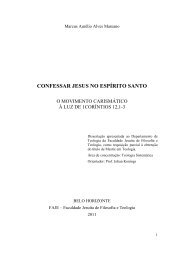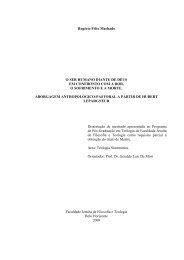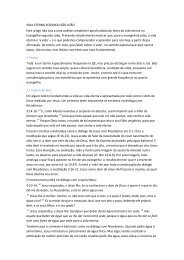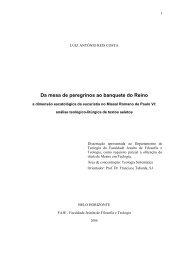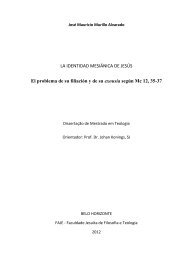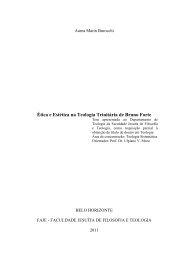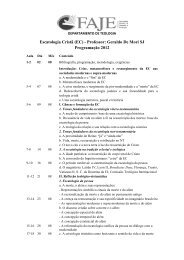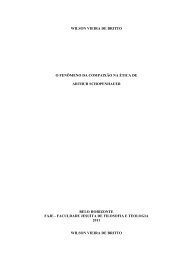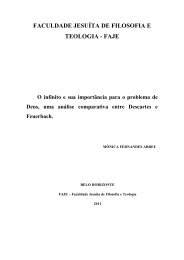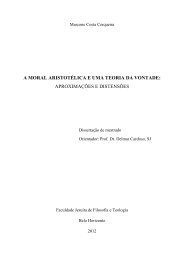o teÃsmo e o problema do mal em richard swinburne - FaJe
o teÃsmo e o problema do mal em richard swinburne - FaJe
o teÃsmo e o problema do mal em richard swinburne - FaJe
Create successful ePaper yourself
Turn your PDF publications into a flip-book with our unique Google optimized e-Paper software.
epist<strong>em</strong>ológico está foca<strong>do</strong> <strong>em</strong> desenvolver uma justificação adequada de<br />
crenças, que aplicada a hipóteses possa fazer delas verdades admissíveis. Ele<br />
postula que a melhor alternativa para esse tipo de conhecimento é a<br />
probabilidade indutiva.<br />
A probabilidade indutiva ou epistêmica refere-se a proposições. Ela é a<br />
medida da extensão <strong>em</strong> que uma proposição r torna outra proposição q<br />
propensa a ser verdadeira. Assumimos a proposição r como verdadeira e<br />
medimos quanto fundamento ela fornece para acreditar que a proposição q<br />
também o é. 42<br />
A probabilidade indutiva indica quanto valor de verdade pode ser<br />
encontra<strong>do</strong> ou espera<strong>do</strong> de uma proposição. A verdade nesse caso não segue<br />
o mesmo padrão sugeri<strong>do</strong> pelos outros tipos de probabilidade já cita<strong>do</strong>s. 43<br />
O autor nos sugere que, com essa forma de quantificação, a<br />
probabilidade indutiva permite-nos reconhecer que uma proposição é<br />
seguramente mais provável <strong>do</strong> que a outra. 44<br />
Para ele, o critério indutivo permite resulta<strong>do</strong>s claros, pois uma<br />
“proposição s<strong>em</strong>pre terá alguma probabilidade sobre outra proposição”<br />
(SWINBURNE, R. 2001. pg.62), poden<strong>do</strong> ainda essa probabilidade ser obtida a<br />
partir de probabilidade física ou estatística.<br />
42 “Inductive probability is a measure of the extent to which one proposition r makes another one<br />
q likely to be true (r and q may be complicated conjunctions or disjunctions of other<br />
propositions).[...] It is concerned with the probability of one proposition or another, where the<br />
second, if true, would give reason for believing the former. We assume the second proposition<br />
to be true, and measure how much reason it provides for believing the first proposition to be.”<br />
(SWINBURNE, Richard. Epist<strong>em</strong>ic Justification. Oxford:. Claren<strong>do</strong>n Press, 2001, p.62).<br />
43 “The inductive probability of q given r, or of q on r (measuring how probable r makes q), has<br />
the value 1 when r makes q certain (that is, when given r, q is certainly true) and the value 0<br />
when r makes not -q (the negation of q) certain, and intermediate values as r gives intermediate<br />
degrees of support to q. Inductive probability (unlike statistical or physical probability) <strong>do</strong>es not<br />
nor<strong>mal</strong>ly have an exact numerical value—it is just high or low, or more than half, or less than<br />
the probability of some different proposition s on a certain other proposition t. Where one<br />
proposition r makes another proposition q no more likely to be true than it would be anyway<br />
(that is, r is irrelevant to q), we can still talk of the probability of q on r, but it will be the same as<br />
the probability of q ‘anyway’.” (SWINBURNE, Richard. Epist<strong>em</strong>ic Justification. Oxford.<br />
Claren<strong>do</strong>n Press, 2001, p.62).<br />
44 “In order to spell out a sharp concept of logical probability, we need to understand the vague<br />
definitions of ‘the probability of q on r is 1’ as ‘r makes q certain’, and ‘the probability of q on r is<br />
0’ as ‘r makes not-q certain’ more precisely. I shall understand ‘r makes q certain’ as ‘r entails<br />
q’; and ‘r makes not-q certain’ as ‘r entails not-q’. ‘Entails’ is being used in the sense of ‘strictly<br />
implies’. p strictly implies q, if it is not logically possible that (p and not -q). Where q is itself<br />
logically necessary, it will never be logically possible that (p and not-q).” (SWINBURNE,<br />
Richard. Epist<strong>em</strong>ic Justification. Oxford. Claren<strong>do</strong>n Press, 2001, p.65).<br />
47



